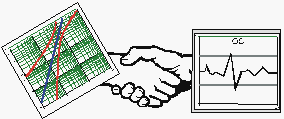Template:Reliability Engineering and Quality Control: Difference between revisions
No edit summary |
|||
| Line 1: | Line 1: | ||
[[File:handshake.gif|center]] | [[File:handshake.gif|center]] | ||
Although the terms ''reliability'' and ''quality'' are often used interchangeably, there is a difference between these two disciplines. While reliability is concerned with the performance of a product over its entire lifetime, quality control is concerned with the performance of a product at one point in time, usually during the manufacturing process. As stated in the definition, reliability assures that components, equipment and systems function without failure for desired periods during their whole design life, from conception (birth) to junking (death). Quality control is a single, albeit vital, link in the total reliability process. Quality control assures conformance to specifications. This reduces manufacturing variance, which can degrade reliability. Quality control also checks that the incoming parts and components meet specifications, that products are inspected and tested correctly, and that the shipped products have a quality level equal to or greater than that specified. The specified quality level should be one that is acceptable to the users, the consumer and the public. No product can perform reliably without the inputs of quality control because quality parts and components are needed to go into the product so that its reliability is assured. | Although the terms ''reliability'' and ''quality'' are often used interchangeably, there is a difference between these two disciplines. While reliability is concerned with the performance of a product over its entire lifetime, quality control is concerned with the performance of a product at one point in time, usually during the manufacturing process. As stated in the definition, reliability assures that components, equipment and systems function without failure for desired periods during their whole design life, from conception (birth) to junking (death). Quality control is a single, albeit vital, link in the total reliability process. Quality control assures conformance to specifications. This reduces manufacturing variance, which can degrade reliability. Quality control also checks that the incoming parts and components meet specifications, that products are inspected and tested correctly, and that the shipped products have a quality level equal to or greater than that specified. The specified quality level should be one that is acceptable to the users, the consumer and the public. No product can perform reliably without the inputs of quality control because quality parts and components are needed to go into the product so that its reliability is assured. | ||
Revision as of 23:27, 2 March 2012

Although the terms reliability and quality are often used interchangeably, there is a difference between these two disciplines. While reliability is concerned with the performance of a product over its entire lifetime, quality control is concerned with the performance of a product at one point in time, usually during the manufacturing process. As stated in the definition, reliability assures that components, equipment and systems function without failure for desired periods during their whole design life, from conception (birth) to junking (death). Quality control is a single, albeit vital, link in the total reliability process. Quality control assures conformance to specifications. This reduces manufacturing variance, which can degrade reliability. Quality control also checks that the incoming parts and components meet specifications, that products are inspected and tested correctly, and that the shipped products have a quality level equal to or greater than that specified. The specified quality level should be one that is acceptable to the users, the consumer and the public. No product can perform reliably without the inputs of quality control because quality parts and components are needed to go into the product so that its reliability is assured.